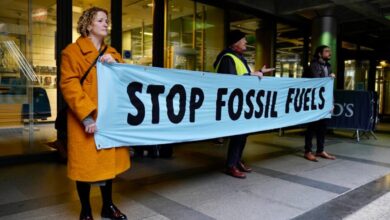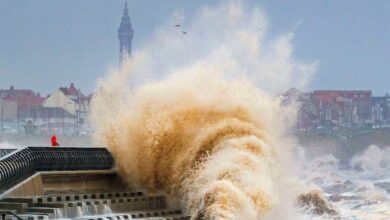‘Everything is dead’: Animal carcasses litter Kenyan landscape as megadrought and climate change collide

As the Horn of Africa struggles with its worst drought in 40 years, nature seems to have turned on its head in Kenya.
Hardy, drought-resistant species like zebras and elephants are dropping dead en masse. Vultures are so fat from feasting on carrion they can barely fly.
In southern Kenya, home to some of the world’s most productive grasslands, bushes stretch for miles without a leaf in sight as animals collapse and die from starvation in the dust near Amboseli National Park.
These are some of the shocking sights captured by wildlife photographer Charlie Hamilton James, who traveled to the region earlier this month alongside the eminent Kenyan conservationist Dr Paula Kahumbu, to document the drought with support from the National Geographic Society.
“Everything is dead,” the photographer told The Independent. “There’s just nothing to eat. It’s parched desert.”
He recalled seeing a zebra who had finally made it to a watering hole, only to drop dead.
“You’d see a lot of dead animals around the watering holes,” he added. “I don’t know what it is. They finally drink water then they just collapse and die.”
But it’s not just a tragedy for the region’s wildlife and agriculture. The combination of drought, livestock death, and ecosystem change are already having a massive impact on the region’s culture, economy, and people. The multi-faceted crisis is a reminder of the ways that climate change can tip already sensitive systems into collapse.
Some 21m people are facing starvation in Somalia, Ethiopia, and Kenya, as the region experiences its fifth successive failed rainy season.
“We are on the brink of an unprecedented humanitarian catastrophe,” Dr Guleid Artan, director of the World Meteorological Organization’s regional climate centre for East Africa, said this summer.
In Kenya, the drought has killed an estimated 2.5m livestock, and the effects of the crisis appear to be moving from the drier north further south and into the country’s normally lush grasslands. In some parts of the country, there hasn’t been major rain for the last three years.
According Dr Kahumbu, a National Geographic Explorer and CEO conservation organisation WildlifeDirect, the roots of the crisis go deeper than climate change alone.
Overgrazing by cattle and other livestock has worn out the soil in various parts of Kenya, stripping grasslands of their resiliency and biodiversity, and allowing the proliferation of tough plants and invasive species that animals avoid using as food.
When a historic drought comes along, livestock and wildlife alike find themselves without enough food to survive.
Grass, unlike most plants, grows from the roots instead of the tips, allowing it to bounce back quickly from even severe ecosystem challenges. But the overgrazing has been so profound there’s little grass left to recover.
Two Maasai communties negotioate over a delivery of maize from a local tourist lodge. With their cattle dying and no crops, communities are suffering across southern Kenya
“A system might be damaged or degraded by overgrazing, but climate change can throw it over the tipping point. That’s what we see in northern Kenya, and that’s what we’re beginning to see in southern Kenya,” Dr Kahumbu said.
“We’ve never seen that before in southern Kenya. We’ve never seen that level of catastrophic collapse, when you wake up in the morning and the ground is littered with dead animals.”
Officials were long warned that such conditions were heading the region’s way, but Dr Kahumbu says the issue was “invisible” for years, owing to the Covid pandemic, elections, and the initial impacts hitting animals but not yet causing widespread human death or starvation.
Now, however, those human impacts are coming to the forefront. Children whose families depended on their livestock for food or income are showing up to school hungry, or leaving because they can’t pay tuition fees. Rural people are being forced to move to cities to find work.
Landscape image from around the edge of Amboseli National Park. There is no grass and the bushes have no leaves due to drought conditions
The carcass of a zebra near Kimana in southern Kenya. Access to water for drinking is not so much the issue – lack of rain has meant there is almost nothing for the animals to eat





